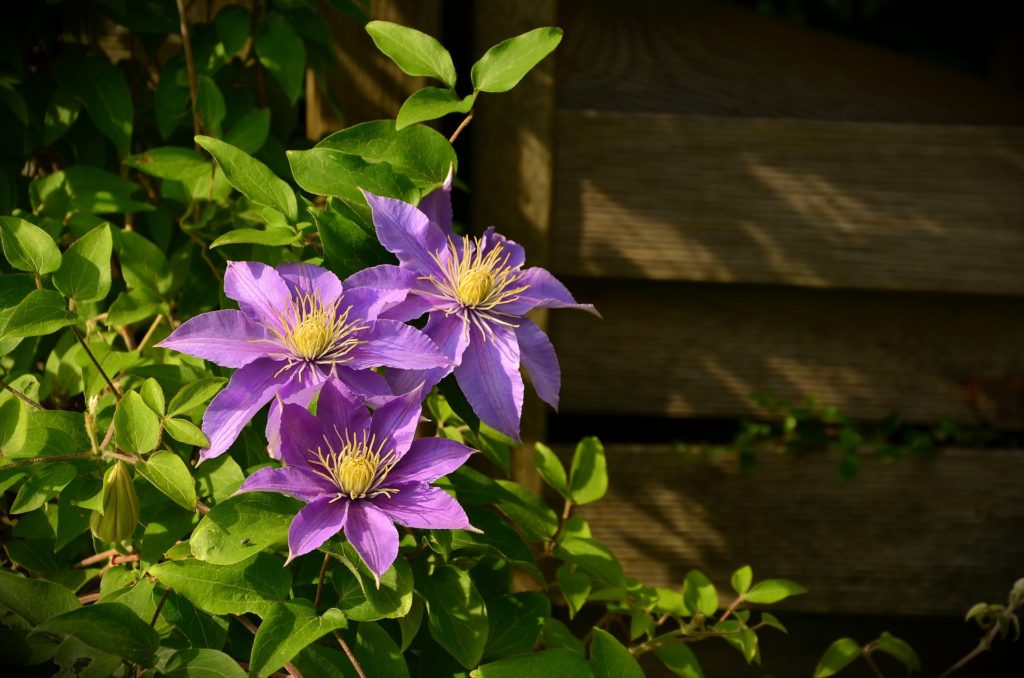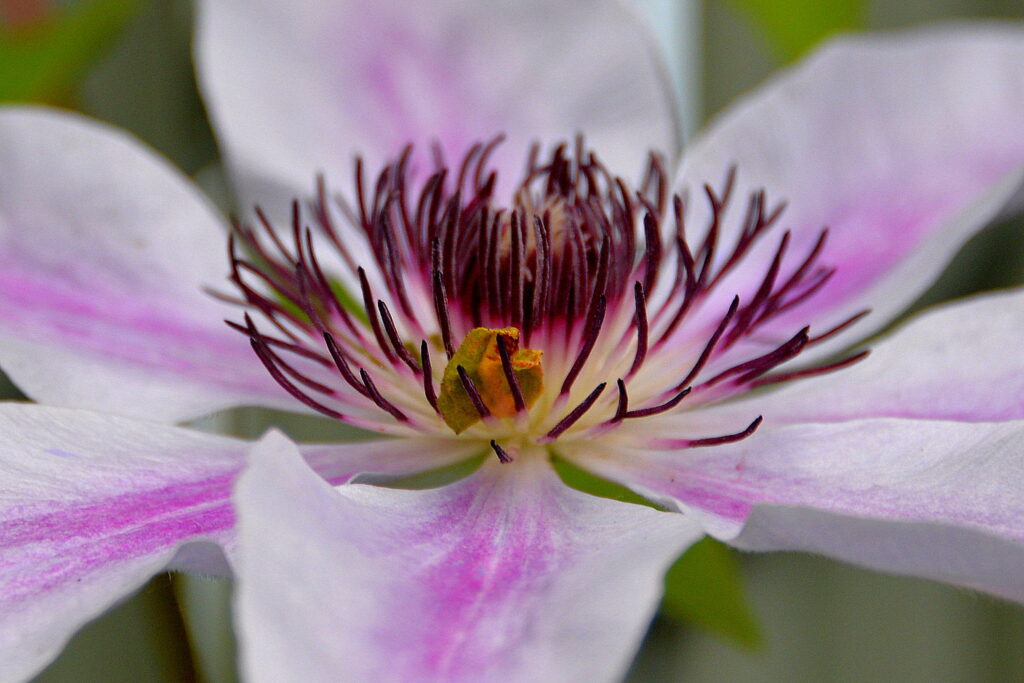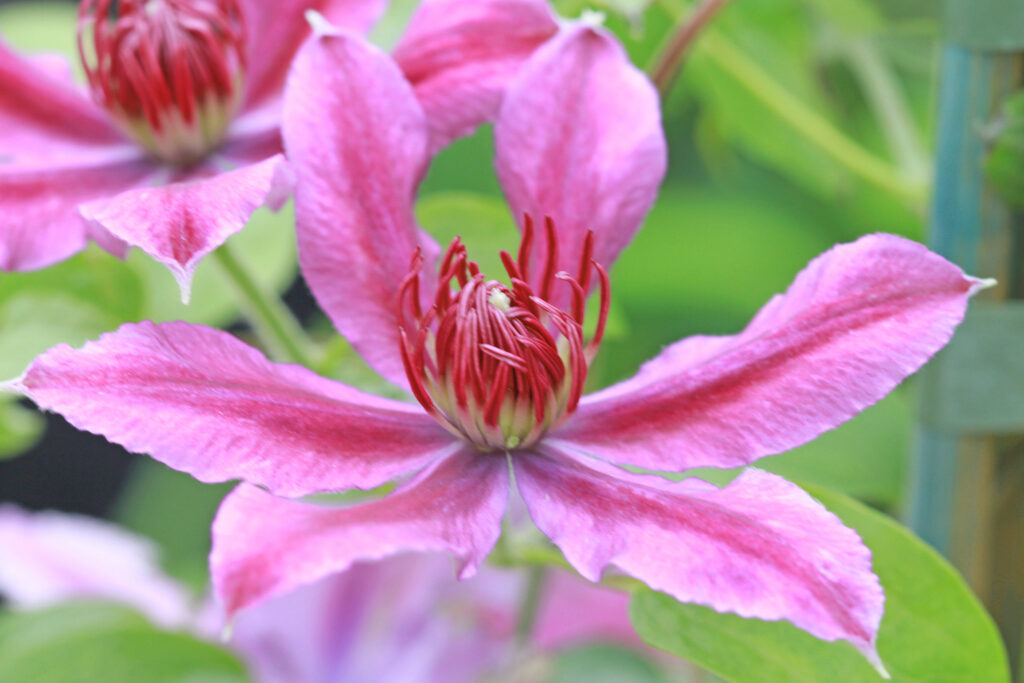Clematis flowers have thousands of individual species from all over the globe, with species native to Eurasia, Africa, Australia, and the Americas. Many are flowering vines that do well climbing up a trellis or pergola, and a few others are smaller and well-suited to containers. The flower size varies for the different varieties. Most of the large-flowered clematis originate from China, Japan, and elsewhere in the far east. Many of these popular varieties were bred and cultivated in England in the nineteenth century after being imported from China.
The Clematis genus of plant species has three main categories, the Early Bloomers, Repeat Bloomers, and Late Bloomers. It’s important to know which group your clematis is in, since that determines when and if pruning should take place. The early bloomers don’t require pruning. The repeat bloomers should be pruned twice a year, and the late bloomers need spring pruning. Within these categories are several groups of plants, each with several individual varieties.
Clematis: Early Bloomers
Evergreen, blooms from December to April – 20-40 foot vines, 1-4 inch white or pink flowers, no pruning, zones 6-9
Alpine, blooms in April to May – 6-10 foot vines, 1-2 inch blue, purple, red, or pink flowers, no pruning, zones 3-9
Macropetala (or downy clematis), blooms in April and May, some re-bloom in summer – 8-12 feet vines, 1-3 inch blue or purple flowers, no pruning, zones 4-9
Montana, blooms from April to June – 20-40 foot vines, 1-2 inch white or pink flowers, no pruning, vigorous growth, zones 6-9
Rockery, bloom April and May – up to 6-foot vines, 1-2 inch white flowers, no pruning, vigorous growth, zones 7-9

Clematis: Repeat Bloomers
Early Large-Flowered, bloom April to June, and again in August to September, 4-12 foot vines, large 6-10 inch blue or purple flowers, prune lightly in early spring and again in early summer, zones 4-11. This group includes the popular Clematis Jackmanii.
Clematis: Late Bloomers
Late Large-Flowered, bloom in summer or fall, 6-12 foot vines, large 5-8 inch blue, purple, red, pink, or white flowers, prune in early spring, zones 4-11.
Herbaceous, bloom in early summer through fall, 12-24 inches in height with ground spread up to 3 feet, white, blue, or red flowers, prune in spring, zones 4-11.
Viticella, bloom from June to October or November, 10-15 foot vines, 3-5 inches blue, pink, and purple flowers, prune in early spring, zones 4-11.
Texensis, bloom from June to December, 10-15 foot vines, 1-3 inch red and orange flowers, prune in early spring, zones 4-8.
Viorna, the leather flowers, bloom from July to August or September, 8-12 foot vines, reddish-purple flowers, prune in late winter or early spring, zones 4-9.
Orientalis, bloom from June to November, 15-20 foot vines, 1-3 inch hanging yellow flowers, prune in early spring, zones 4-11.
Late Mixed Species, bloom from July to November, 6-30 foot vines (depending on species), 1-2 inch white or purple flowers, prune in late winter or early spring, zones 5-9.
There are several varieties of Clematis native to the United States. The largest group of species is Clematis Texensis, which originated in Texas. The Viorna group includes two common varieties, Clematis Crispa, from the southeastern United States and Clematis Hirsutissima, a small non-vining variety often called Hairy Clematis which originated in the Pacific Northwest.
- Clematis
- Perennial
- Full sun, but keep the roots shaded.
- Moist and well-drained neutral soil (6.5 to 7.5 pH).
- Start cuttings indoors.
- Plant rooted cuttings in the garden in the summer.
- Purchased plants can be planted from mid-spring to fall.
- Plant 24 inches apart
- Growing in containers:
Choose a large clay pot with good drainage.
Plant an existing plant for best results, though cuttings can also be planted.
Keep it growing in full sun, with the roots and pot shaded.
Repot every three years or so.
- Water regularly, keeping the soil moist.
- Climate Zones: Usually 4-9, some varieties hardy down to zone 2, and some up to zone 11.

Clematis can be started from seeds or cuttings, but cuttings are much easier. Seeds take a few years to germinate. If you purchase a young clematis from a garden shop, it is almost certainly started from a cutting. If you are doing the cuttings yourself from an existing plant, do it during the spring season. Cuttings can be taken in summer or autumn, but it’s harder, the vines are more mature, and they are slower to take root. Cut a few vines with several leaves branching off the main stem, but no flowers. With scissors, cut the vines into sections, an inch or so above each set of branching leaves. This should leave you with several sections, each a few inches long with a pair of leaves at the top. Plant sets of 4 stems into a 6-inch wide pot with good starting soil and ensure the soil is firm around each stem.
Keep them in a moist environment. In humid areas, no cover is needed, but when I have grown clematis, I have found it best to keep the pots covered with a large plastic bag. I use a wire hanger, bent to keep the bag supported above the cuttings. Not all the cuttings will take root, but the ones that do will start growing within two months. Remove the bag, and they should grow pretty quickly at this point. Once they get to be 18 inches or so tall, trim them back a bit to encourage branching. Plant them in the garden in late July or August.
Location is important. It should have good quality neutral and well-drained soil. Full sun is essential, but the roots need some shade. I keep some big rocks handy to place around the roots, to keep the sun off. Companion plants can also be used around the base of the plant. Good ones for clematis include lettuce and other edible greens, as well as annual or perennial flowers to help shade the roots. For clematis, there is a well-known saying that is very useful: “Head in the sun, and feet in the shade.” Other companions can be shrubs and trees to provide a natural trellis.
Clematis should be planted with enough room to grow fully. Smaller varieties can be planted as close as 18 inches apart, the largest vines need 36 inches, but 24 inches is a good standard distance for most. They will need a trellis. Before actually planting them, put up the trellis, the best kind has a small lattice, about 5 or 6 feet tall. In the first year, trim them back a little by removing the tip ends since these coaxes the plant into branching out. Pruning is important for many varieties, but not the early bloomers. See the description above for more specific information about pruning year to year. Young plants need some protection from the cold. Start them after the last frost if you are planting already rooted clematis in the spring.
Container planting is a popular option for many types of clematis. Smaller varieties are easier but if you have a good-sized large pot, the vining types will do well with a trellis. In some ways, growing in containers is easier, because this allows them to be moved inside during the coldest weather. Also, the soil can be kept moist and fresh more easily.
Use good quality potting soil mixed with sand and compost. Transplant the clematis into a large clay pot with good drainage. The container should be at least 12 inches wide, and 18 inches deep. Carefully fill in the soil around the base of the vine. Water the new plant thoroughly. Keep the pot outside in full sun with a wire trellis. The roots should be shaded. Keep your plant well watered, ensuring that the soil remains moist but not soggy. All clematis grown in pots should be pruned regularly for the first three years, by pinching off the tips of new stems. This will divert the plant’s energy into root development. After three years, prune as you would for garden clematis.

Clematis has a few common pests to watch out for, such as aphids, earwigs, and vine weevils. Aphids can be removed with a hard spray of water. Earwigs can be prevented by mixing some dishwashing soap with water and spraying the plants. Vine weevils can be controlled by using diatomaceous earth, scattered around the base of the plant.
There are a few diseases common to clematis. Powdery mildew can be treated with neem oil. Slime flux is shown by a liquid secretion under wilting leaves. This is a bigger problem. The plant should be completely removed and disposed of away from the garden, and the soil should be replaced. Clematis wilt is the most well-known disease. The stem will turn black and collapse. This is not always fatal, clematis can recover from this. Infected leaves and stems should be removed and carefully gathered from around the base of the plant to prevent further infection.
Diseases can be prevented by choosing resistant varieties, choosing healthy planting sites with lots of good sun, and well-drained healthy soil. Be sure to water at ground level, and not by spraying from above. Weed carefully and keep the plant free from fallen leaves and stems.
If you want to attempt the challenge of propagating by seeds, wait until the flowers are completely ripe and are starting to turn brown. The seed heads will be green and have some hairs growing around them. Clip some seed heads and open them over a container, and check the color. Brown seeds are ripe, green ones are not. They can be planted directly in the garden, but bear in mind that it may take a few years for them to germinate and sprout.
Once they are established, clematis is extremely easy to care for and they live for decades! These wonderful varieties of vining flowers will last a lifetime and create a beautiful backdrop on any fence, or pergola or be a beautiful long-term addition to your potted plant collection.











